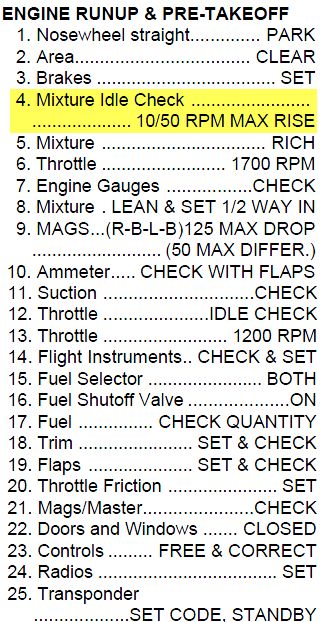eetrojan
Pattern Altitude
Can any of you more experienced folks explain what the author of this checklist for a Cessna 172R or 172S is doing in step 4, and why?



Except that the OP's checklist is not the checklist in the POH. The "Mixture Idle Check" item does not appear in either the factory 172R or 172S manual.Cessna simply left that item in when they switched to the injected engine. to do other wise means the must rewrite the POH / Owners manual/flight manuals and get them all approved the the certification process.
Except that the OP's checklist is not the checklist in the POH. The "Mixture Idle Check" item does not appear in either the factory 172R or 172S manual.
Then , what is he reading? I don't have a R or S POH.
Or should I be asking why anyone would read any other check list than what in the POH?
You can make your own checklists but they can not exclude anything in the official POH example.People make their own checklists

My experience with my 172 is I want to see a 50 RPM rise in shut down with the mixture, is this a mistake on the check list?
In fact, on checking the old manuals in my file, it doesn't appear that the "Mixture Idle Check" item has ever been in any factory-published checklist for the C-170 or C-172.
I fly both models and never do a mixture idle check.
Originally Posted by Tom-D
Cessna simply left that item in when they switched to the injected engine. to do other wise means the must rewrite the POH / Owners manual/flight manuals and get them all approved the the certification process.
In fact, on checking the old manuals in my file, it doesn't appear that the "Mixture Idle Check" item has ever been in any factory-published checklist for the C-170 or C-172.

Thanks All.
The checklist is provided by the flight school. The same entry re a “Mixture Idle Check … 10/50 RPM MAX RISE” appears in the checklists for both the Cessna 172R and the 172S, i.e. for the two models with fuel injected engines.
I didn’t author it. I’m asking about it, though, because I’m working on my own custom checklist and, so far, I can’t find anything supporting it in the POH or anywhere else.
The item does not appear in the school’s custom checklist for their older, carbureted Cessna 172P, nor so far as I can tell, in the POH for the 172P, 172R, or 172S.
Since I will be doing my instrument training in these planes, I wanted to completely understand them. I don't currently have an instructor to ask, so you're my huckleberry.
I’m certainly not positive, but I think Henning’s comment in post #3 may be on the right track. But, if it’s not mentioned in the POH, is it just a known technique borrowed from somewhere else?
Thanks again for any speculation or insight!

I was able to get some comments from my former PPL instructor re the mysterious (to me) runup entry for "Mixture Idle Check … 10/50 RPM MAX RISE". Consistent with Henning's post #15 re it being a "maintenance check," he says that I should ignore it during runup, that it's "just for maintenance."
I have no idea why they keep this on their daily-driver checklists.

Pilots almost never do unless they are mechanics, then it's just part of normal shut down to watch for a rise on the tach. Not sure why someone put it on that list.
I always thought "Mixture Idle Check" was after leaning the plane before take off, after the run up, you pull the throttle back to Idle, to see if the engine would still have enough fuel to keep the motor running when you chopped the power on approach, or elsewhere.
A rich enough mixture at 1700 rpm might not run at 600? Hence, "Mixture Idle Check".
Do you have a reference for any of that?That's right. An "idle check" is to check that the idle position won't quit when you pull to idle on final. To do it realistically, the mixture should be in the anticipated position it would be on final, probably full rich, but not necessarily. I do it after the mag check runup, I bring the throttle sharply back hard against the stop, trying to see if it will quit, then let it idle 10 - 15 seconds to see if it idle smoothly, then back up to recommended idle.
I had one quit in flight at idle, so I check - checklist or not.
In a separate check on the mixture, before the runup, with the tach needle precisely on the 1000 rpm line, so I can see the slightest movement, I squeeze the mixture back from full rich to see if it rises about 25/50, then starts dropping, which is what it should do because it is a little rich at the full in position.
If it gains 100/200 rpm, which it will on an extremely hot day, 100°F or so, or at highaltitude airports, or at combinations of the two, then I know to set the mixture to best rpm for take off, and not to go full rich before landing.
If you're in flight at idle, why do you care if it dies? It'll come right back up when you put the throttle back in.
If you're in flight at idle, why do you care if it dies? It'll come right back up when you put the throttle back in.
Do you have a reference for any of that?
